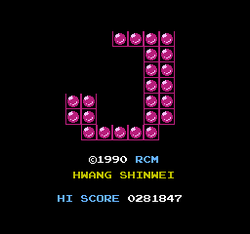Software:Magic Jewelry
| Magic Jewelry | |
|---|---|
 Title screen | |
| Publisher(s) | RCM Group |
| Programmer(s) | Hwang Shinwei |
| Platform(s) | NES |
| Release | November 21, 1990 |
| Genre(s) | Puzzle |
| Mode(s) | Single-player |
Magic Jewelry (Chinese: 魔法寶石; pinyin: Mófǎ Bǎoshí; literally: 'Magic Gems'), is an unlicensed Nintendo NES tile-matching puzzle video game derivative to Columns, programmed in Taiwan by Hwang Shinwei and published by RCM in 1990.[1]
Like many Taiwanese low-sized unlicensed games, it is most commonly found on pirate Famicom/NES multicarts and systems which have many games. Multicarts and Famicom/NES clones usually remove copyright information, and Magic Jewelry is no exception, despite being unlicensed. Various unofficial remakes have been released for iOS and Android.[2][3][4]
Gameplay
Magic Jewelry's gameplay resembles that of Columns and Dr. Mario, both of which released earlier in the same year. Sets of 3 or more matching coloured jewels must be lined up horizontally, vertically or diagonally in order to score points, while simultaneously removing said jewels. The jewels drop down in blocks of 3, and their positions in the blocks can be shifted freely until the block lands. After a certain number of jewels are cleared, a flashing "X" block drops, which upon landing on a jewel clears out all other jewels of the same colour, and the game advances to the next level, with the default drop speed of the blocks increasing. The game ends when a block is stacked with at least one jewel being over the top edge of the board.
Music
The tracks played in Magic Jewelry are 8-bit versions of some copyrighted songs, along with pitch shifted and fast paced versions of some of the tracks in Levels 8-15; Shinwei also used the same themes on some of his other Famicom/NES unlicensed games [citation needed]. The tracks appear as such:
| Lvl | Alt lvl(s) | Song | Original artist |
|---|---|---|---|
| 0 | 8, 12 | "All Kinds of Everything" | Dana |
| 1 | 9, 11, 13 | "Happy Chinese Festival" (or "China Festival") | Chen Yang |
| 2 | 10, 14 | "Descendants of the Dragon" | Lee Chien-Fu (written by Hou Dejian) |
| 3[lower-alpha 1] | 15 | "Rise from Your Grave" | Tohru Nakabayashi |
| 4 | — | "Jägerchor (Hunters' Chorus)" | Carl Maria von Weber |
| 5 | "Moonlight on the Colorado" | Dick Robertson | |
| 6 | "Greensleeves" | — | |
| 7 | "Speak Softly Love" | Andy Williams |
Legacy
Magic Jewelry II (Chinese: 寶石方塊二代; pinyin: Bǎoshí Fāngkuài Èr Dài; literally: 'Gemstone Second Generation') was released in 1991. The game has features advanced title screen, section of choose block, choose start stage level and additional sound effects, The most significant addition is a two-player competitive mode.[5]
Notes
- ↑ In Level 3 there's only one non-existent song, because it's taken from an arcade game, namely, Sega's Altered Beast Round 1 and 4.
References
- ↑ Magic Jewelry Release Information for NES - GameFAQs
- ↑ Magic Jewelry HD on the App Store on iTunes
- ↑ Magic Jewelry HD - Android Apps on Google Play
- ↑ Magic Jewelry - Android Apps on Google Play
- ↑ Also one additional song The Tennessee Waltz by The Cowboys Copas on Level 5 and Moonlight On The Colorado became the theme for Level 8Magic Jewelry II
External links
- Magic Jewelry at GameSpot

